Feline Diarrhea
Usually feline diarrhea lasts less than 24 hours, as it is most often caused by something the cat ate that did not agree with its tummy. So even though there are many serious illnesses the diarrhea may be a symptom of, it is most likely your cat only has a temporary discomfort.
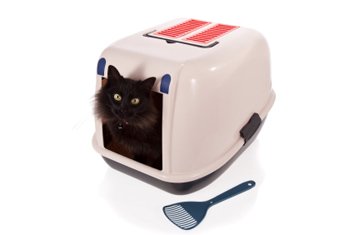 |
You may not notice if the cat’s feces are runny, because being the tidy animal it is, the cat uses the litter box and the clumping cat litter often hides the evidence of feline diarrhea. Or perhaps your cat is an outdoor cat and doesn’t use litter box much. Still, you should notice other symptoms related to feline diarrhea – and if you do, get your cat to the vet sooner rather than later. |
These other symptoms of feline diarrhea are loss of appetite and weight, abdominal pain and fever.There may be vomiting and lethargy. The cat may keep on washing its bottom, and you notice signs of feces there (even matted fur under its tail, if the situation is bad). There may also be tenderness of the hind end.
If the condition continues over 24 hours, and the feces are either very watery or contain blood, it is time to go the vet. Remember to do this quickly as diarrhea in cats is much more dangerous than it is in humans.
In prolonged feline diarrhea the cat needs to have a physical exam. The vet checks its temperature, abdomen tenderness and swelling (by palpation), signs of dehydration, heart and respiration, mouth, thyroid size, and does a chemical profile of the kidneys and liver functions (urinalysis). Also, obviously, the feces need to be microscopically evaluated.
Dehydration
Because the feces are so watery, dehydration is a real danger for cats. And it should not be taken lightly – it may cause the death of the cat through shock and collapse.
Also, if the cat is still very young (a kitten that has not yet received all of its vaccinations and thus has an underdeveloped immune system), its condition may deteriorate very fast. So, if your cat is still a kitten, it is most important you immediately contact your vet at the first signs of feline diarrhea. If the cat is lethargic, has an unusually fast heartbeat and thick saliva, you really need to rush.
When the cat becomes dehydrated , it loses important minerals and salts like chloride, electrolytes, sugars, potassium and sodium, which are important for the function of the cat’s nerves. Dehydration also causes acid-based imbalance.
Dehydration can be fatal because a small animal has a large surface area in proportion to their weight. So, when the liquid stools eject too much liquid from the cat’s body it has trouble keeping its body temperature because of this large surface area – it cools the body too fast. If this happens, the cat may go into a coma. If the situation goes this far, only intravenous fluids can help.
How then to check if you cat is dehydrated? It is easy. Hold your cat firmly to the ground and then pull up the scruff of the neck gently. Keep it at that position for a few seconds and then let go. The scruff shouldgo down to normal quickly. But if it remains tented, it is a sign your cat is dehydrated - and you should ask for advice from your veterinarian quickly.
Another test is to press the gum lightly with your finger. The pressed area should o white and then quickly return to pink. But if it doesn’t and you notice white on the gums, or they are yellowish, you need to call your vet fast.
And the third easy sign of dehydration is that the third eyelid (the yaw) shows.
Young cats
With very young cats the intestinal inflammation can cause the intestines to trash with such force that they go literally into knots. And even a layman understands that such a situation is life-threatening. And , like mentioned above, a young kitten with an underdeveloped immune system is in real danger if it gets diarrhea.
Symptoms of Severe Diarrhea
Symptoms of Severe Feline Diarrhea
There are symptoms that reveal the cat has a severe diarrhea. If you see any of these, they may be a sign of cat enteritis where the cat’s intestines are damaged. So contact your vet immediately. These symptoms are:
- Abdominal pain
- Bloody feces (you can wipe t with a paper towel, this makes it easier to see if there is blood). The condition where there is bright red blood in the feces is called hematochezia and it is a sign of bleeding in the lower intestines or rectum. And the condition called melana shows dark, tar-like feces which is usually a sign of bleeding in the intestines instead of the lower tract.
- Feline diarrhea lasts more than 48 hours.
- Dehydration
- Depression (the cat stops eating and grooming)
- Diarrhea worsens
- Fever
- Increased thirst
- Lethargy
- Loss of appetite (Not eating is very dangerous to cats even though there is a deep rooted belief a cat can survive with no food for a long time.)
- Vomiting
- Weight loss
If your cat’s symptoms are mixed – there is both diarrhea and constipation – it could be it has eaten some sharp object.
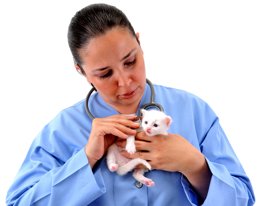
At the Vet
When you get to the vet, it is good if you have written down some things that really help the vet to make a fast and accurate diagnosis.
- Your cat’s medical history: its vaccinations (especially feline distemper and leukemia), what wormers you have used, your cat’s contact with other animals. All this preferably in chronological order.
- How often does your cat go to the toilet and does it strain while there?
- Is there blood or mucus in the feces? Or is the stool perhaps black or tarry?
- Have you noticed your cat rubbing its rear on carpets? (Looks hilarious, but is actually a symptom of anal sac problems)
- Do you think your cat has been eating something it shouldn’t have? Like human food, milk, nibbling at some plant? Or do you know your cat has broken some household item so that it might have eaten bits of it? Has it been to your sewing box? Christmas tree tinsel? Rubber bands or strings?
- Have you changed your cat’s diet lately? Which brand are you feeding to your cat at the moment?
- Has there been a change in your cat’s appetite?
- Has there been a change in your cat’s drinking patterns? Does it drink more or less than before?
- Has your cat lost weight?
- Has you cat been vomiting?
- Has your cat lost weight?
- Is your cat on some medication, like antibiotics? Remember to mention wormers and flea control.
- Have you given your cat any human medication (this is an absolute no-no, you should not medicate your cat on your own, but if you have, best admit to it as it may save your feline friend’s life). Acetylsalicylic acid (Aspirin) and acetaminophen (Tylenol) are very toxic to cats.
- Has your cat experienced stress lately?
- Are there any other symptoms of illness?
- Is anyone else in your household showing signs of illness? Animal or people.
- Has your cat eaten anything that might be toxic? (Chemicals, antifreeze, plants etc)
Also ask your vet if you need to bring a sample of the diarrhea with you. This might be a good idea, because it may not be easy to get at the vets – remember the cat’s stomach is trying to empty itself constantly so there might not be much there to take samples of. A few tablespoonfuls in a sealed bag or container will do. If it is hard to get the sample from the cat sand, change the litter to something else (beans have been suggested) – or put just paper on the bottom of the litter box.
Remember to wash your hands well when you have taken the sample or cleaned the litter box. Even if it is feline diarrhea, it may be infectious to people as well. For example giardia and toxoplasmosis cross species. So, if both your cat and a person in your household has diarrhea, the people should go to the doctor as well. If the person in question is a child or an already sick person, this can be life threatening.
Often your vet finds the cause of the feline diarrhea immediately by sieving the feces, or then under a microscope.
Depending on what caused the diarrhea, the feces may look quite different. Also there may be blood loss which may cause feline anemia.
- Black and tarry feces means there is bleeding in the upper intestine tract. Contact your vet immediately.
- Bloody feces (bright red or rusty colored blood) means the cat has bleeding in its lower bowel or colon.
- Foamy / frothy feces reveal a bacterial infection
- Gooey feces with lots of mucus may be a sign of colitis. You may also need to add dietary fiber to your cat’s diet.
- Gray colored feces with bad smell, in large quantities mean that the cat has a digestion problem.
- If the feces are greasy, the cat has a mal-absorption problem
- light colored feces may be a sign of gall bladder, liver- or pancreatic disease
- Soft and bulky feces mean that you have been overfeeding the cat, or that the food has been of low quality (or both)
- If the feces smell of sour milk, it is a sign of overfeeding the cat. If the feces are smelly and “pudding-like”, it may be a sign of a dietary intolerance. But it can also be a sign of inflammatory bowel disease. Really foul smell means the cat has an internal infection (feline panleukopenia).
- Watery feces tell that the cat has bowel wall problems (enteritis)
- Very frequent bowel movements suggest the cat has colitis.
- Yellow feces tell that stool moved fast through the digestive system.
The cause of feline diarrhea may be in the intestines, but this is not always the case. If the reason is in the intestines, the cat’s lymph nodes are often enlarged (they collect the lymph from the intestines).
If the cause of feline diarrhea is in the small (or high) intestine, it is more dangerous. The symptoms are large amounts of feces with foul odor. There is normal or increased amount of bowel movements and not much straining when the cat defecates. There may be increased flatulence. The feces are not sticky, thick or covered with mucus. There may be blood in the feces, but it is usually brown on color, not bright red. (Usually darker blood in feces is a sign of a serious problem). Usually, however, there is no blood. The cat may vomit and have abdominal pain. Weight loss is also common.
If the cause of feline diarrhea is in the large (or low) intestine (rectum), there are frequent, uncomfortable bowel movements. There is a small amount of feces, which is often covered with large amounts of mucus. Pooping takes a long time, the cat has difficulties in passing and may not succeed at first. If there are flecks of blood (red or rusty in color) in the stool, it can be a sign of a badly inflamed colon. usually there is no weight loss, increased gas or weight loss.
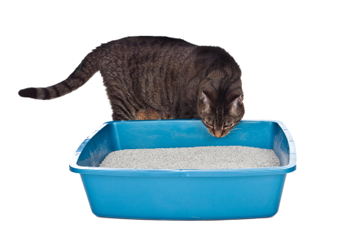
Tests to find out the cause of the feline diarrhea:
You can read more about cat diarrhea treatment by clicking here!
Click here to go back to illnesses related to cat diarrhea.
Disclaimer: This website is not intended to replace professional consultation, diagnosis, or treatment by a licensed veterinarian. If you require any veterinary related advice, contact your veterinarian promptly. Information at cat-breeds-info.com is exclusively of a general reference nature. Do not disregard veterinary advice or delay treatment as a result of accessing information at this site.

Back to Homepage from Feline Diarrhea
Back to Cat Diarrhea Related Illnesses
Go to Cat Diarrhea Treatment
Back to Cat Illnesses Main Page
Leena's Books
Tutankhamun
|
This book travels with the King Tut - Treasures of the Golden Pharaoh exhibition on his world tour of ten cities from March 2018 onwards |
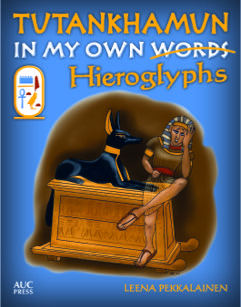 |
|
Tutankhamun: In My Own Hieroglyphs tells the story, for older children, of the life and afterlife of the famous young pharaoh in his own words. Tutankhamun tells us about the trouble he got into as a child in Akhenaten's palace in the new city of Akhetaten, and how he became a boy pharaoh. As we learn, his life changed a lot when he died as a teenager, and long years of boredom started in his tomb with only his pet monkey Fingers and his treasure for company. He did meet some of the Egyptian gods, of course, and had fun scaring off tomb robbers, but it was mostly rather dull. Then one day, some new and strange people, including a Mr. Howard Carter, arrived and began to take all the treasures out of his royal tomb. Fortunately, through the eyes of his beautiful golden mask, Tutankhamun, could have fun again traveling around the world |
Mr Mummific
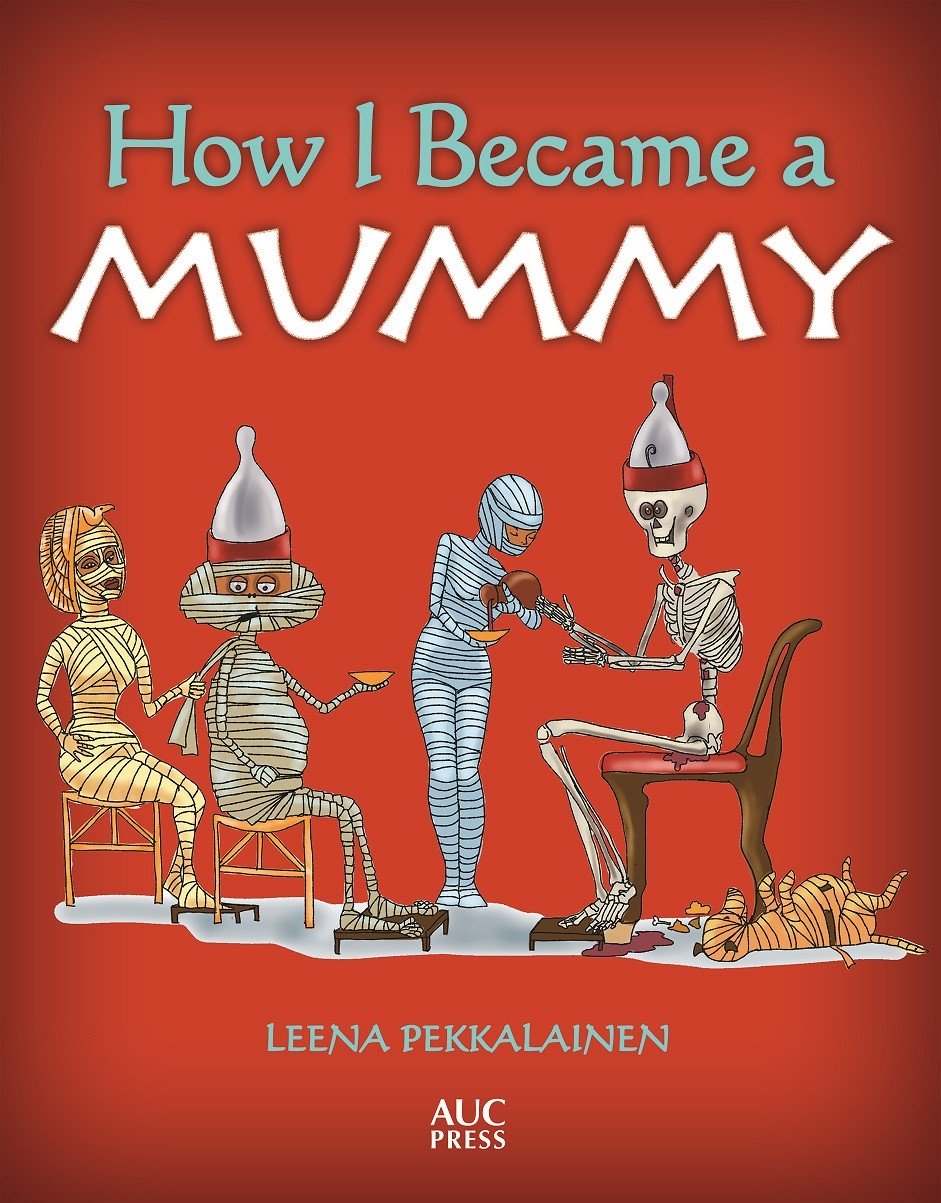
|
An ancient friend of mine, Mr Mummific dictated a book about how he became a mummy - and I was his scribe and artist. The book is available at Amazon.com and Amazon.co.uk On my other website www.ancientagypt101.com he continues his stories about life in ancient Egypt. |
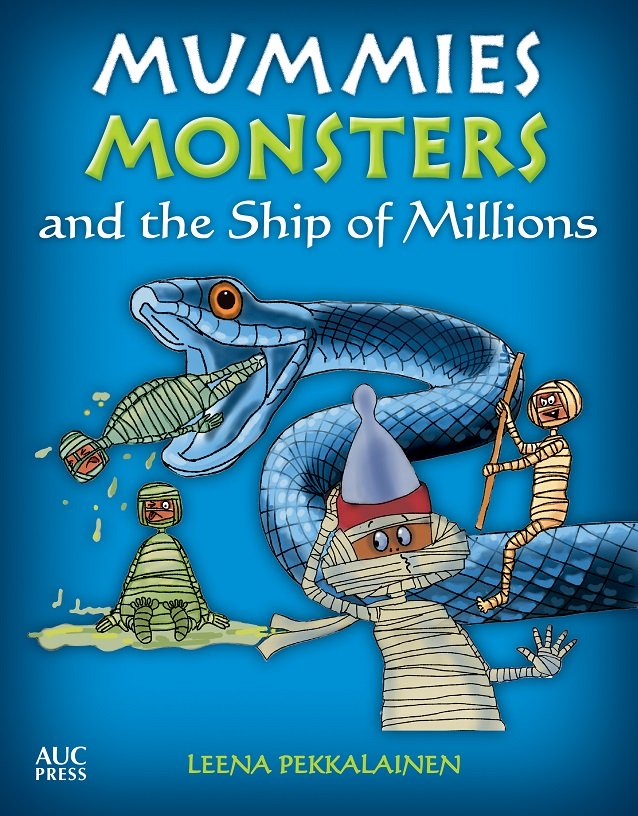
|
Another hilarious adventure for children with Mr Mummific, the mummy with attitude. He now tells the story of his mishaps, misunderstandings and misadventures as he leaves his tomb through the False Door to embark on the complicated and dangerous journey to the Afterlife aboard the magnificent Ship of Millions. Find the book at Amazon.com and Amazon.co.uk |
The Nephilim Quest Series
The first book in an epic fantasy series based on human mythology. The search for the mythical Watchers, the angels who fathered the Nephilim, the half-angels. A story that moves on three levels - our times, ancient Greece and ancient Egypt.
Preview Nephlim Quest 1: Shadowhunter online
***
My Author Website at leenasbooks.com
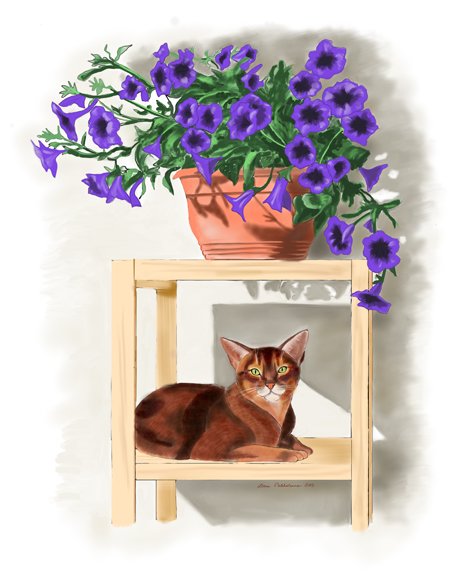
If you are looking for demanding coloring, check:
Online Coloring Books Magazine - No.1
It shows you step by step how to color this pretty Abyssinian cat with flowers. Each page has a color sample, and all the techniques are explained.






